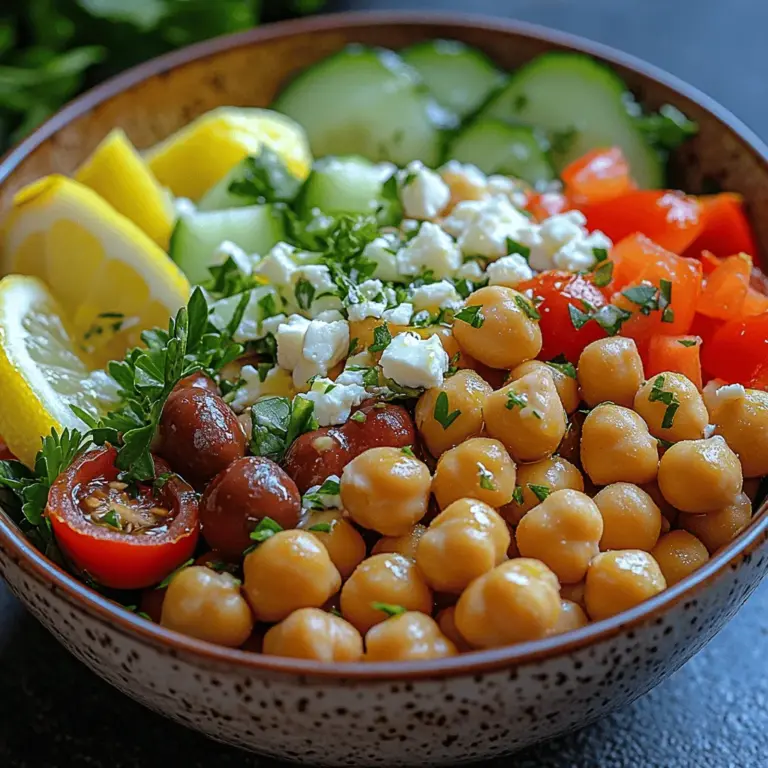Introduction
Mediterranean cuisine is celebrated worldwide for its vibrant flavors, fresh ingredients, and numerous health benefits. Rooted in the culinary traditions surrounding the Mediterranean Sea, this diet emphasizes the use of whole foods, healthy fats, and a variety of colorful fruits and vegetables. With an array of flavors that dance on the palate, Mediterranean dishes are not only delicious but also packed with nutrients.
One standout recipe that embodies the essence of Mediterranean cooking is the Mediterranean Chickpea Salad Bowl. This dish marries the earthiness of chickpeas with the freshness of vegetables, making it a nutritious and visually appealing option for any meal. As more individuals gravitate towards plant-based meals, the Mediterranean Chickpea Salad Bowl is gaining popularity not only for its taste but also for its health advantages.
Understanding the Ingredients
At the heart of the Mediterranean Chickpea Salad Bowl lies a harmonious blend of key ingredients that contribute to its flavor and nutritional profile.
Chickpeas are the star of this dish. Often referred to as garbanzo beans, these legumes are not only a staple in Mediterranean cooking but also a powerhouse of nutrition. Rich in protein, fiber, and essential vitamins and minerals, chickpeas provide a satisfying base for the salad. Their high fiber content aids digestion and helps maintain stable blood sugar levels, making them an excellent choice for those seeking to manage their weight or support overall health.
The fresh vegetables in this salad play a crucial role as well. Ingredients such as cucumbers, tomatoes, and bell peppers add a refreshing crunch and vibrant colors. Cucumbers, low in calories and high in water content, are perfect for hydration, while tomatoes are rich in antioxidants like lycopene, which have been linked to numerous health benefits, including reduced risk of chronic diseases. Bell peppers, bursting with vitamins A and C, enhance the nutritional value of the salad while providing a sweet, crunchy texture.
Olives and feta cheese are also integral to the Mediterranean diet. Olives, with their rich, briny flavor, are a source of healthy monounsaturated fats that can support heart health. They are also high in antioxidants, which can help combat inflammation. Feta cheese, a staple in many Mediterranean dishes, adds creaminess and depth of flavor. Made from sheep’s milk, it is lower in fat than many other cheeses and provides a good source of protein and calcium.
Herbs such as parsley and mint are essential for elevating the flavors of the salad while also offering numerous health benefits. Parsley is rich in vitamins K and C and has been shown to have anti-inflammatory properties. Mint, with its refreshing taste, not only enhances the flavor profile but also aids in digestion and adds a unique twist to the dish.
Health Benefits of Mediterranean Diet
The Mediterranean diet is characterized by its emphasis on whole foods, including fruits, vegetables, whole grains, legumes, nuts, and healthy fats, particularly olive oil. This diet is not just a collection of recipes; it embodies a lifestyle that promotes balance and moderation. Research has shown that adhering to a Mediterranean-style diet can significantly support heart health, reduce the risk of chronic diseases, and aid in weight management.
One of the key principles of the Mediterranean diet is the inclusion of plant-based proteins, such as chickpeas, beans, and legumes. These foods are not only nutrient-dense but also provide essential amino acids necessary for the body’s functions. Incorporating plant-based proteins into meals can help improve overall health and support sustainable eating practices.
Step-by-Step Guide to Preparing Mediterranean Chickpea Salad Bowls
Preparing the Dressing
The first step in creating the Mediterranean Chickpea Salad Bowl is preparing a flavorful dressing that will tie all the ingredients together. A simple yet delicious dressing can elevate the dish and enhance its freshness. Here’s how to make it:
1. Gather Your Ingredients: You will need extra virgin olive oil, fresh lemon juice, minced garlic, and a pinch of salt and pepper. Optional additions can include Dijon mustard or honey for a touch of sweetness.
2. Mix the Dressing: In a small bowl, whisk together about 1/4 cup of extra virgin olive oil with the juice of one large lemon. Add one to two cloves of minced garlic, depending on your preference for garlic intensity. Season with salt and pepper to taste. If you’re using Dijon mustard or honey, add a teaspoon of each for an extra layer of flavor.
3. Taste and Adjust: Once combined, taste the dressing and adjust the seasoning as necessary. A well-balanced dressing should be tangy, savory, and slightly sweet, complementing the other ingredients in your salad.
4. Set Aside: Allow the dressing to sit for a few minutes to let the flavors meld together while you prepare the other components of the salad.
{{image_2}}
Importance of Homemade Dressings Versus Store-Bought
When it comes to salads, the dressing can make or break the dish. While store-bought dressings are convenient, they often contain preservatives, unhealthy fats, and excessive sugar. Making your own dressing not only allows you to control the ingredients but also enhances the flavors of your Mediterranean Chickpea Salad Bowl. A homemade dressing can be tailored to your taste preferences, giving you the freedom to experiment with different herbs, spices, and acidity levels.
Flavor Contributions of Each Dressing Ingredient
For the Mediterranean Chickpea Salad, we’ll use a simple yet flavorful dressing made from olive oil, lemon juice, garlic, Dijon mustard, salt, and pepper. Here’s a breakdown of how each ingredient contributes to the overall flavor profile:
– Olive Oil: This is the base of your dressing, adding a rich, fruity flavor while also providing healthy fats.
– Lemon Juice: The acidity from lemon juice brightens the dressing and balances the richness of the olive oil, giving the salad a refreshing zing.
– Garlic: Fresh minced garlic adds a robust flavor that enhances the overall taste of the salad, providing depth and warmth.
– Dijon Mustard: This ingredient introduces a subtle tanginess and creaminess, helping to emulsify the dressing while also contributing a hint of spice.
– Salt and Pepper: Essential for bringing out the flavors of all the ingredients, these seasonings help to elevate the dish.
Creating the Salad Base
Tips for Selecting Fresh Produce
The success of your Mediterranean Chickpea Salad Bowls starts with fresh, high-quality ingredients. Here are some tips for selecting the best produce:
1. Visual Inspection: Look for vibrant colors and firm textures. Avoid any vegetables with blemishes or soft spots.
2. Seasonality: Choose seasonal vegetables for maximum flavor and freshness. For instance, cucumbers and tomatoes are at their best in summer.
3. Local Sourcing: If possible, buy from local farmers’ markets. This not only ensures freshness but also supports your local economy.
Techniques for Properly Chopping Vegetables
Evenly chopped vegetables not only enhance the presentation but also ensure each bite is packed with flavor. Here are some techniques:
– Uniform Sizes: Aim for consistent sizes for even cooking and flavor distribution. For example, chop cucumbers and bell peppers into bite-sized pieces.
– Using the Right Knife: A sharp chef’s knife is essential for clean cuts. Dull knives can bruise produce and lead to uneven sizes.
– Chopping Techniques: Use a rocking motion when chopping to maintain control and speed. For herbs, gather them into a tight bundle and slice them thinly for a fine chop.
Combining the Ingredients
Best Practices for Mixing Salads
To maintain texture and flavor integrity, follow these best practices:
1. Layering Ingredients: Start by adding the chickpeas, followed by the chopped vegetables, and then the dressing. This ensures the dressing evenly coats all components without making the salad soggy.
2. Gentle Tossing: Use a large spoon or salad tongs to gently toss the salad. Avoid aggressive stirring, which can bruise the vegetables.
3. Timing: If preparing in advance, consider dressing the salad just before serving. This prevents the vegetables from wilting and keeps the salad crisp.
Adjusting Seasoning and Dressing
Taste is subjective; therefore, it’s essential to adjust the seasoning based on your personal preference:
– Taste Before Serving: Always taste your salad before serving to ensure it meets your flavor expectations. You can easily add more salt, pepper, or lemon juice if needed.
– Dressing Consistency: If the dressing is too thick, whisk in a little water or extra lemon juice to achieve your desired consistency.
Assembling the Bowls
Suggestions for Serving Sizes and Presentation
When assembling your Mediterranean Chickpea Salad Bowls, consider portion sizes that are appropriate for your occasion:
– Individual Bowls: For personal servings, aim for 1 to 1.5 cups of salad per bowl, depending on the appetite of your guests.
– Family Style: For a gathering, you can serve the salad in a large bowl, allowing guests to serve themselves. This encourages sharing and makes for a more interactive meal.
Ideas for Garnishing
Enhance the visual appeal of your salad with these garnishing ideas:
– Fresh Herbs: Sprinkle chopped parsley or mint on top for a burst of color and freshness.
– Feta Cheese: Crumbled feta adds creaminess and a salty kick, perfectly complementing the salad’s flavors.
– Olives: A few Kalamata olives can add depth and a touch of Mediterranean flair.
Serving Suggestions and Pairings
Ideal Occasions for Serving Mediterranean Chickpea Salad Bowls
This versatile salad is perfect for various occasions:
– Lunch: Serve it as a light, refreshing lunch that’s both satisfying and nutritious.
– Dinner: Pair with grilled chicken or fish for a wholesome dinner option.
– Gatherings: Ideal for potlucks and picnics, where it can be made ahead and served cold.
Complementary Dishes to Serve Alongside
To create a well-rounded meal, consider these complementary dishes:
– Grilled Vegetables: A side of grilled zucchini, eggplant, or bell peppers adds a smoky flavor that pairs beautifully with the freshness of the salad.
– Hummus and Pita: Serve with a side of hummus and warm pita bread for a Mediterranean-inspired feast.
– Quinoa or Couscous: Offer a scoop of quinoa or couscous to add more texture and heartiness to the meal.
Ideas for Variations and Additions
Feel free to customize your Mediterranean Chickpea Salad Bowls with these variations:
– Different Proteins: Add grilled chicken, shrimp, or tofu for a protein boost.
– Grains: Mix in cooked grains like quinoa, farro, or bulgur for added texture and nutrition.
– Dressings: Experiment with different dressings such as tahini, balsamic vinaigrette, or a yogurt-based dressing for a unique twist.
Conclusion
The Mediterranean Chickpea Salad Bowls are the epitome of a delicious, healthy, and versatile dish. With their vibrant colors, fresh flavors, and satisfying textures, they are sure to please anyone at your table. The combination of chickpeas and fresh vegetables not only makes for a nutritious meal, but the homemade dressing elevates the dish to new heights.
Incorporating this salad into your regular meal planning can provide numerous nutritional benefits while simplifying your cooking routine. Whether enjoyed for lunch, dinner, or at gatherings, these salad bowls are a delightful way to embrace healthy eating. So why wait? Gather your fresh ingredients and try this recipe today. You won’t regret it!


